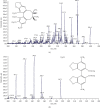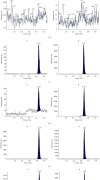HPLC-MS/MS-Mediated Analysis of the Pharmacokinetics, Bioavailability, and Tissue Distribution of Schisandrol B in Rats
- PMID: 33679983
- PMCID: PMC7929678
- DOI: 10.1155/2021/8862291
HPLC-MS/MS-Mediated Analysis of the Pharmacokinetics, Bioavailability, and Tissue Distribution of Schisandrol B in Rats
Abstract
Schisandrol B, a lignan isolated from dried Schisandra chinensis fruits, has been shown to exhibit hepatoprotective, cardioprotective, renoprotective, and memory-enhancing properties. This study sought to design a sensitive and efficient HPLC-MS/MS approach to measuring Schisandrol B levels in rat plasma and tissues in order to assess the pharmacokinetics, oral bioavailability, and tissue distributions of this compound in vivo. For this analysis, bifendate was chosen as an internal standard (IS). A liquid-liquid extraction (LLE) approach was employed for the preparation of samples that were subsequently separated with an Agilent ZORBAX Eclipse XDB-C18 (4.6 × 150 mm, 5 μm) column with an isocratic mobile phase consisting of methanol and water containing 5 mM ammonium acetate and 0.1% formic acid (90 : 10, v/v). A linear calibration curve was obtained over the 5-2000 ng/mL and 1-1000 ng/mL ranges for plasma samples and tissue homogenates, respectively. This established method was then successfully applied to investigate the pharmacokinetics, oral bioavailability, and tissue distributions of Schisandrol B in Sprague-Dawley (SD) rats that were intravenously administered 2 mg/kg of Schisandrol B monomer, intragastrically administered Schisandrol B monomer (10 mg/kg), or intragastrically administered 6 mL/kg SCE (equivalent to 15 mg/kg Schisandrol B monomer). The oral absolute bioavailability of Schisandrol B following intragastric Schisandrol B monomer and SCE administration was approximately 18.73% and 68.12%, respectively. Tissue distribution studies revealed that Schisandrol B was distributed throughout several tested tissues, with particular accumulation in the liver and kidneys. Our data represent a valuable foundation for future studies of the pharmacologic and biological characteristics of Schisandrol B.
Copyright © 2021 Dahu Liang et al.
Conflict of interest statement
All authors of this manuscript declare no conflicts of interest.
Figures




Similar articles
-
Distribution study of cisplatin in rat kidney and liver cancer tissues by using liquid chromatography electrospray ionization tandem mass spectrometry.J Mass Spectrom. 2015 Jun;50(6):844-53. doi: 10.1002/jms.3594. J Mass Spectrom. 2015. PMID: 26169139
-
Simultaneous determination of five lignan constituents of Wuzhi capsule in rat plasma by LC-MS/MS: application to pharmacokinetic study.J Pharm Biomed Anal. 2010 Sep 5;52(5):741-6. doi: 10.1016/j.jpba.2010.02.003. Epub 2010 Feb 10. J Pharm Biomed Anal. 2010. PMID: 20227218
-
Determination of Epimedin B in Rat Plasma and Tissue by LC-MS/MS: Application in Pharmacokinetic and Tissue Distribution Studies.J Anal Methods Chem. 2017;2017:7194075. doi: 10.1155/2017/7194075. Epub 2017 Jun 1. J Anal Methods Chem. 2017. PMID: 28656123 Free PMC article.
-
Pharmacokinetics of Schizandrin and Its Pharmaceutical Products Assessed Using a Validated LC-MS/MS Method.Molecules. 2018 Jan 15;23(1):173. doi: 10.3390/molecules23010173. Molecules. 2018. PMID: 29342955 Free PMC article.
-
Pharmacokinetics and Tissue Distribution of Anwuligan in Rats after Intravenous and Intragastric Administration by Liquid Chromatography-Mass Spectrometry.Molecules. 2019 Dec 20;25(1):39. doi: 10.3390/molecules25010039. Molecules. 2019. PMID: 31861927 Free PMC article.
Cited by
-
An analysis of the nutritional effects of Schisandra chinensis components based on mass spectrometry technology.Front Nutr. 2023 Jul 25;10:1227027. doi: 10.3389/fnut.2023.1227027. eCollection 2023. Front Nutr. 2023. PMID: 37560060 Free PMC article. Review.
-
Antioxidant Effects of Schisandra chinensis Fruits and Their Active Constituents.Antioxidants (Basel). 2021 Apr 18;10(4):620. doi: 10.3390/antiox10040620. Antioxidants (Basel). 2021. PMID: 33919588 Free PMC article. Review.
-
Pharmacokinetics and Main Metabolites of Anwulignan in Mice.Front Pharmacol. 2022 Jul 5;13:929177. doi: 10.3389/fphar.2022.929177. eCollection 2022. Front Pharmacol. 2022. PMID: 35865951 Free PMC article.
-
A comprehensive review of Schisandra chinensis lignans: pharmacokinetics, pharmacological mechanisms, and future prospects in disease prevention and treatment.Chin Med. 2025 Apr 9;20(1):47. doi: 10.1186/s13020-025-01096-z. Chin Med. 2025. PMID: 40205412 Free PMC article. Review.
References
LinkOut - more resources
Full Text Sources
Other Literature Sources

